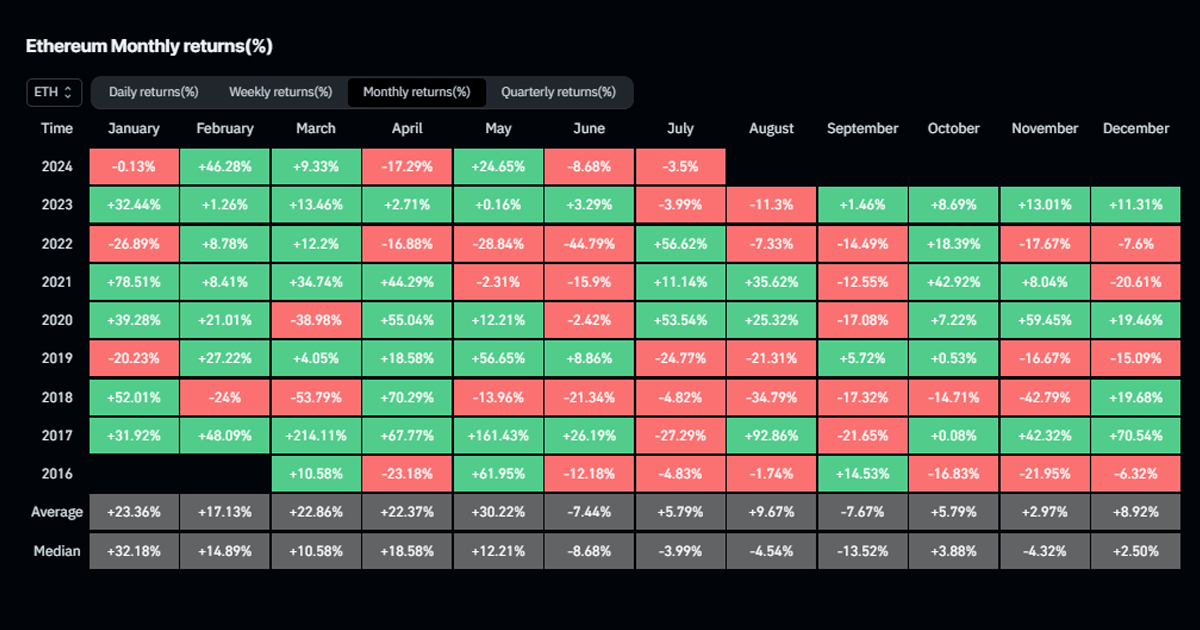Ethereum
Where crypto angel investors should deploy capital after Ethereum ETF approval

The following is a guest post from Tim Haldorsson, CEO of Lunar Strategy.
In nine short years, Ethereum has evolved from being a pioneer of on-chain smart contracts and programmable cryptography to becoming the backbone of decentralized finance and blockchain infrastructure. The SEC’s recent approval of ETH ETFs is just a single step in this journey, although it is an important one that has solidified Ethereum’s status as a worthy mature asset class a serious investment.
This opinion piece will highlight the most promising sectors of the Ethereum ecosystem that I believe angel investors should closely monitor to take advantage of this economic momentum.
Layer 2 decentralized finance (DeFi)
Ethereum paved the way for the birth of decentralized on-chain markets, planting the seeds that blossomed a global DeFi sector with a market capitalization of $104.55 billion. DeFi is a complex rabbit hole filled with unique financial mechanisms unparalleled in traditional finance. However, they rely on the security, speed and decentralization offered by Ethereum smart contracts. Layer 2 networks like Base, Arbitration, and zkSync emerged to solve Ethereum’s scalability issues, reducing usage costs and increasing transaction speeds without sacrificing privacy or security. These improvements make Ethereum’s technology more accessible and perfect for DeFi activities.
In the DeFi space, projects such as lending and borrowing platforms, futures and perpetual trading platforms, token seeding and launch platforms, as well as centralized and decentralized exchanges have emerged. proved extremely successful. Even back when ETH was only attracting the attention of a small niche of market participants, these technologies were being transformed into a myriad of business models that were proving real demand for DeFi solutions at scale. Some of the leading DeFi protocols have even reached multi-billion dollar valuations, highlighting the strength of this sector.
As Ethereum becomes a recognized commodity, DeFi’s future growth potential becomes even more certain, making it a lucrative area for angel investors to deploy capital.
Artificial intelligence
Artificial intelligence is one of the most important technologies of our time, comparable to the impact of blockchain technology. The world needs AI technologies that are reliable and free from centralized control.
Blockchain enables secure, private, decentralized frameworks for AI services, essential to preventing monopolies over scarce computing resources and providing broader access to decentralized machine learning networks. By leveraging the Ethereum blockchain for AI projects, developers are already creating AI services that remain secure and decentralized.
This intersection of AI and blockchain provides an attractive playing field for investment as demand for decentralized and secure AI solutions continues to rise. AI projects built on Ethereum have already reached market caps in the billions of dollars, showing discerning observers that it is a powder keg of explosive growth. The recent approval of ETH ETFs could be the spark that ignites the next stage of expansion this sector is ready for.
Decentralized Physical Infrastructure (DePIN)
Of pine is one of the exciting blockchain-dependent sectors that have emerged through the miracle of smart contracts. In a nutshell, it merges physical infrastructure with digital networks of decentralized participants and facilitates the global exchange of limited but in-demand resources such as sensors, data storage or wireless connectivity in exchange for cryptographic tokens.
DePINs provide decentralized governance, peer-to-peer infrastructure sharing, tokenization, and enhanced security and privacy for traditional and digital industries.
As the demand for DePIN increases, the market for these resources will also increase, leading to token appreciation and market expansion. Ethereum powers the smart contracts that execute these DePINs, making it a crucial part of this ecosystem. With the recent approval of ETH ETFs, more angel investors will likely turn to DePINs, recognizing their high return potential and significant real-world impact.
ETH takeover
Staking is a fundamental aspect of securing decentralized networks like Ethereum through economic game theory. Validators, who manage the nodes powering the blockchain, are required to stake ETH. If they follow the rules, they earn rewards; if they try to cheat, they lose their staked ETH. Currently, over $100 billion worth of ETH is at stake— this shows how important this mechanism is for the functioning of blockchain networks.
Resttaking takes this concept further by applying the same game theory to secure any protocol on the blockchain. This allows small participants to maintain high levels of security through proof-of-stake mechanisms that would otherwise be inaccessible. Rollback helps create a more resilient network for multiple protocols, making it prohibitive to attack a single participant within the larger proof-of-stake pool.
Liquid restake services further simplify the process for those looking to stake tokens without managing complex validators. These services issue liquid restoration tokens, which accumulate the yield and interest of validator rewards and can be traded or re-staked to generate additional rewards. The growth of this sector highlights its importance as a pillar of blockchain security, making it a hot area for angel investors.
Conclusion
The approval of ETH ETFs has made Ethereum one of the leading investment vehicles. The Ethereum ecosystem offers many exciting opportunities for angel investors, from Layer 2 DeFi and AI integration to DePINs and retaking.
It is important to study these sectors and understand both their key narratives and their growth catalysts. This way, investors can deploy smart capital while contributing to the growth of Ethereum.
Ethereum
QCP sees Ethereum as a safe bet amid Bitcoin stagnation

QCP, a leading trading firm, has shared key observations on the cryptocurrency market. Bitcoin’s struggle to surpass the $70,000 mark has led QCP to predict Selling pressure is still strong, with BTC likely to remain in a tight trading range. In the meantime, Ethereum (ETH) is seen as a more promising investment, with potential gains as ETH could catch up to BTC, thanks to decreasing ETHE outflows.
Read on to find out how you can benefit from it.
Bitcoin’s Struggle: The $70,000 Barrier
For the sixth time in a row, BTC has failed to break above the $70,000 mark. Bitcoin is at $66,048 after a sharp decline. Many investors sold Bitcoin to capitalize on the rising values, which caused a dramatic drop. The market is becoming increasingly skeptical about Bitcoin’s rise, with some investors lowering their expectations.
Despite the continued sell-off from Mt. Gox and the US government, the ETF market remains bullish. There is a notable trend in favor of Ethereum (ETH) ETFs as major bulls have started investing in ETFs, indicating a bullish sentiment for ETH.
QCP Telegram Update UnderlinesIncreased market volatility. The NASDAQ has fallen 10% from its peak, led by a pullback in major technology stocks. Currency carry trades are being unwound and the VIX, a measure of market volatility, has jumped to 19.50.
The main factors driving this uncertainty are Value at Risk (VaR) shocks, high stock market valuations and global risk aversion sentiment. Commodities such as oil and copper have also declined on fears of an economic slowdown.
Additionally, QCP anticipates increased market volatility ahead of the upcoming FOMC meeting, highlighting the importance of the Federal Reserve’s statement and Jerome Powell’s subsequent press conference.
A glimmer of hope
QCP notes a positive development in the crypto space with an inflow of $33.7 million into ETH spot ETFs, which is giving a much-needed boost to ETH prices. However, they anticipate continued outflows of ETHE in the coming weeks. The recent Silk Road BTC moves by the US government have added to the market uncertainty.
QCP suggests a strategic trade involving BTC, which will likely remain in its current range, while ETH offers a more promising opportunity. They propose a trade targeting a $4,000-$4,500 range for ETH, which could generate a 5.5x return by August 30, 2024.
Ethereum
Ethereum Whale Resurfaces After 9 Years, Moves 1,111 ETH Worth $3.7 Million

An Ethereum ICO participant has emerged from nearly a decade of inactivity.
Lookonchain, a smart on-chain money tracking tool, revealed On X, this long-inactive participant recently transferred 1,111 ETH, worth approximately $3.7 million, to a new wallet. This significant move marks a notable on-chain movement, given the participant’s prolonged dormancy.
The Ethereum account in question, identified as 0xE727E67E…B02B5bFC6, received 2,000 ETH on the Genesis block over 9 years ago.

This initial allocation took place during the Ethereum ICOwhere the participant invested in ETH at around $0.31 per coin. The initial investment, worth around $620 at the time, has now grown to millions of dollars.
Recent Transactions and Movements
The inactive account became active again with several notable output transactions. Specifically, the account transferred 1,000 ETH, 100 ETH, 10 ETH, 1 ETH, and 1 more ETH to address 0x7C21775C…2E9dCaE28 within a few minutes. Additionally, it moved 1 ETH to 0x2aa31476…f5aaCE9B.
Additionally, in the latest round of transactions, the address transferred 737,995 ETH, 50 ETH, and 100 ETH, for a total of 887,995 ETH. These recent activities highlight a significant movement of funds, sparking interest and speculation in the crypto community.
Why are whales reactivating?
It is also evident that apart from 0xE727E67E…B02B5bFC6, other previously dormant Ethereum whales are waking up with significant transfers.
In May, another dormant Ethereum whale made headlines when it staked 4,032 ETHvalued at $7.4 million, after more than two years of inactivity. This whale initially acquired 60,000 ETH during the Genesis block of Ethereum’s mainnet in 2015.
At the time, this activity could have been related to Ethereum’s upgrade known as “Shanghai,” which improved the network’s scalability and performance. This whale likely intended to capitalize on the price surge that occurred after the upgrade.
Disclaimer: This content is informational and should not be considered financial advice. The opinions expressed in this article may include the personal opinions of the author and do not reflect the opinion of The Crypto Basic. Readers are encouraged to conduct thorough research before making any investment decisions. The Crypto Basic is not responsible for any financial losses.
-Advertisement-
Ethereum
Only Bitcoin and Ethereum are viable for ETFs in the near future

BlackRock: Only Bitcoin and Ethereum Are Viable for ETFs in the Near Future
Bitcoin and Ethereum will be the only cryptocurrencies traded via ETFs in the near future, according to Samara Cohen, chief investment officer of ETFs and indices at BlackRock, the world’s largest asset manager.
In an interview with Bloomberg TV, Cohen explained that while Bitcoin and Ethereum have met BlackRock’s rigorous criteria for exchange-traded funds (ETFs), no other digital asset currently comes close. “We’re really looking at the investability to see what meets the criteria, what meets the criteria that we want to achieve in an ETF,” Cohen said. “Both in terms of the investability and from what we’re hearing from our clients, Bitcoin and Ethereum definitely meet those criteria, but it’s going to be a while before we see anything else.”
Cohen noted that beyond the technical challenges of launching new ETFs, the demand for other crypto ETFs, particularly Solana, is not there yet. While Solana is being touted as the next potential ETF candidate, Cohen noted that the market appetite remains lacking.
BlackRock’s interest in Bitcoin and Ethereum ETFs comes after the successful launch of Ethereum ETFs last week, which saw weekly trading volume for the crypto fund soar to $14.8 billion, the highest level since May. The success has fueled speculation about the next possible ETF, with Solana frequently mentioned as a contender.
Solana, known as a faster and cheaper alternative to Ethereum, has been the subject of two separate ETF filings in the US by VanEck and 21Shares. However, the lack of CME Solana futures, unlike Bitcoin and Ethereum, is a significant hurdle for SEC approval of a Solana ETF.
Despite these challenges, some fund managers remain optimistic about Solana’s potential. Franklin Templeton recently described Solana as an “exciting and major development that we believe will drive the crypto space forward.” Solana currently accounts for about 3% of the overall cryptocurrency market value, with a market cap of $82 billion, according to data from CoinGecko.
Meanwhile, Bitcoin investors continue to show strong support, as evidenced by substantial inflows into BlackRock’s iShares Bitcoin Trust (NASDAQ: IBIT). On July 22, IBIT reported inflows of $526.7 million, the highest single-day total since March. This impressive haul stands in stark contrast to the collective inflow of just $6.9 million seen across the remaining 10 Bitcoin ETFs, according to data from Farside Investors. The surge in IBIT inflows coincides with Bitcoin’s significant $68,000 level, just 8% off its all-time high of $73,000.
Ethereum
Ethereum Posts First Consecutive Monthly Losses Since August 2023 on New ETFs

Available exclusively via
Bitcoin ETF vs Ethereum: A Detailed Comparison of IBIT and ETHA
Andjela Radmilac · 3 days ago
CryptoSlate’s latest market report takes an in-depth look at the technical and practical differences between IBIT and BlackRock’s ETHA to explain how these products work.
-

 Ethereum12 months ago
Ethereum12 months agoEthereum Posts First Consecutive Monthly Losses Since August 2023 on New ETFs
-

 Regulation12 months ago
Regulation12 months agoCryptocurrency Regulation in Slovenia 2024
-

 News12 months ago
News12 months agoNew bill pushes Department of Veterans Affairs to examine how blockchain can improve its work
-

 Regulation12 months ago
Regulation12 months agoThink You Own Your Crypto? New UK Law Would Ensure It – DL News
-

 Regulation12 months ago
Regulation12 months agoUpbit, Coinone, Bithumb Face New Fees Under South Korea’s Cryptocurrency Law
-

 Regulation12 months ago
Regulation12 months agoA Blank Slate for Cryptocurrencies: Kamala Harris’ Regulatory Opportunity
-

 Regulation12 months ago
Regulation12 months agoBahamas Passes Cryptocurrency Bill Designed to Prevent FTX, Terra Disasters
-

 Regulation12 months ago
Regulation12 months agoIndia to Follow G20 Policy for Cryptocurrency Regulation: MoS Finance
-

 News1 year ago
News1 year ago“Captain Tsubasa – RIVALS” launches on Oasys Blockchain
-

 Ethereum1 year ago
Ethereum1 year agoComment deux frères auraient dérobé 25 millions de dollars lors d’un braquage d’Ethereum de 12 secondes • The Register
-

 News12 months ago
News12 months agoEU supports 15 startups to fight online disinformation with blockchain
-

 News1 year ago
News1 year agoSolana ranks the fastest blockchain in the world, surpassing Ethereum, Polygon ⋆ ZyCrypto















